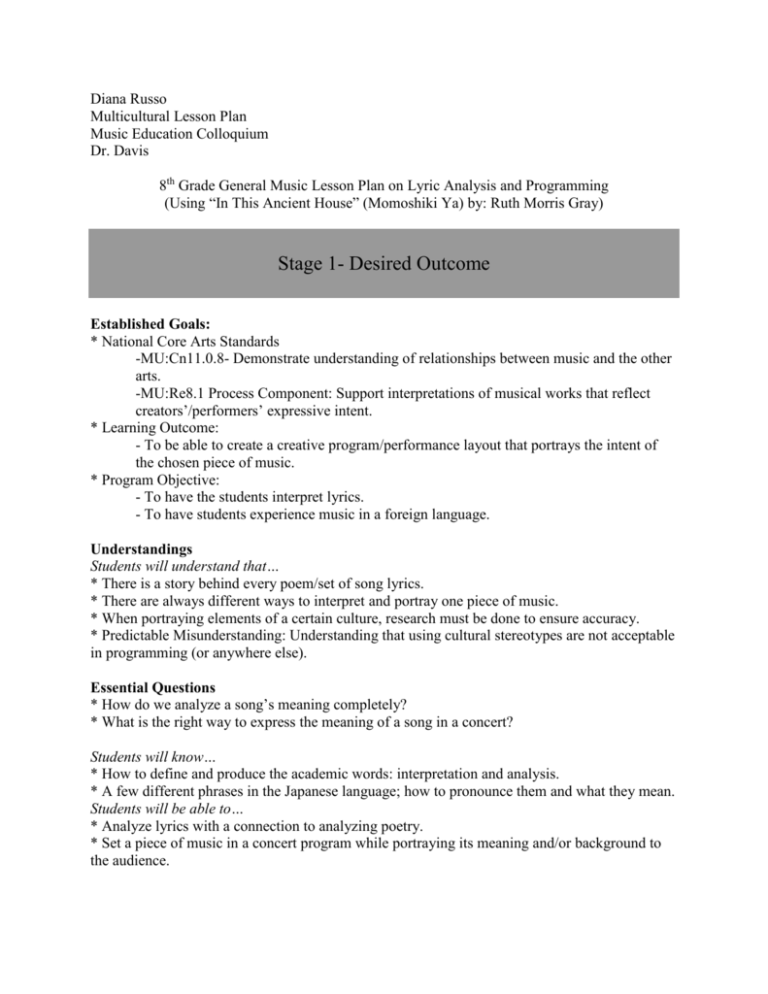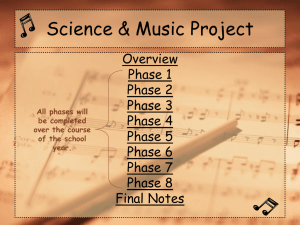File - Diana Russo Musician & Educator
advertisement

Diana Russo Multicultural Lesson Plan Music Education Colloquium Dr. Davis 8th Grade General Music Lesson Plan on Lyric Analysis and Programming (Using “In This Ancient House” (Momoshiki Ya) by: Ruth Morris Gray) Stage 1- Desired Outcome Established Goals: * National Core Arts Standards -MU:Cn11.0.8- Demonstrate understanding of relationships between music and the other arts. -MU:Re8.1 Process Component: Support interpretations of musical works that reflect creators’/performers’ expressive intent. * Learning Outcome: - To be able to create a creative program/performance layout that portrays the intent of the chosen piece of music. * Program Objective: - To have the students interpret lyrics. - To have students experience music in a foreign language. Understandings Students will understand that… * There is a story behind every poem/set of song lyrics. * There are always different ways to interpret and portray one piece of music. * When portraying elements of a certain culture, research must be done to ensure accuracy. * Predictable Misunderstanding: Understanding that using cultural stereotypes are not acceptable in programming (or anywhere else). Essential Questions * How do we analyze a song’s meaning completely? * What is the right way to express the meaning of a song in a concert? Students will know… * How to define and produce the academic words: interpretation and analysis. * A few different phrases in the Japanese language; how to pronounce them and what they mean. Students will be able to… * Analyze lyrics with a connection to analyzing poetry. * Set a piece of music in a concert program while portraying its meaning and/or background to the audience. Stage 2- Assessment Evidence Performance Tasks: * The students will pronounce the Japanese phrases with me correctly. They will say the translations to confirm the connection and to understand the song structure, which bounces back and forth from the English to Japanese translation of the same phrase. * The students will be broken up into small groups and be asked to design a programming plan for “In This Ancient House.” A programming plan is a plan made to determine how to present a piece of music to the audience through the performance and program. This can include incorporating the piece’s meaning, historical background, and/or culture. Other Evidence: * Homework: Students will be asked to pick a song of their choice and describe how they would format it into a concert. * Quiz: Students will be asked to analyze lyrics from a song of my choosing and analyze it to the best of their ability. This quiz would be graded using a holistic rubric. Stage 3- Learning Plan Learning Activities: * I will leave the essential questions on the board for the entire class period. * At the beginning of the class, I will ask the students if anyone can define the word interpretation and/or analysis. - I will then properly define the words for clarification. - This will equip the students with the academic language being used throughout the lesson. * I will then play the recording of “In This Ancient House (Momoshiki Ya)” as performed by Chameleonic from their website’s homepage: http://www.chameleonicnyc.org/ - Before I play the recording, I will give out a handout (see below) with the lyrics, Japanese pronunciations, origin of the song, and some historical background. Handout sources: http://en.wikipedia.org/wiki/Emperor_Juntoku Heritage Music Press’s SAB Edition of “In This Ancient House” by: Ruth Morris Gray -This will give them a first impression of what we will be interpreting and analyzing, and will show them where the lesson is going. -The music will also hook their interest. * I will then refer to the author of the poem: Emperor Juntoku, as explained on the handout, and play them this short video: http://www.youtube.com/watch?v=1xGX_pv_gp0 - This video will give them a chance just to concentrate on the words, see the Japanese characters, and connect with where Emperor Juntoku was coming from. * After the recording, I will ask for questions on the piece to get their ideas flowing. After a few responses, I will respond with my thoughts of how interesting and intriguing the language is. - Possible Questions: What emotions do you feel when listening to the music? How do the lyrics explain the emperor’s story? Can we still relate to the lyrics in today’s world? - This will help to organize my time and easily flow into the next activity. * I will then help the students pronounce the Japanese phrases to get a feel for the song and culture behind it. - I will ask the class if anyone speaks Japanese to see if I could have a helper. This will help tailor the class to any student that has a background in this culture or has studied the Japanese language. * After the mini language lesson, I will introduce the activity. The students will be broken up into small groups and be asked to design a programming plan for “In This Ancient House.” -They will use a summary frame (see below) as their guideline to help them summarize all their ideas about the song. -Each group should create a unique way to present the meaning, historical background and/or culture to the audience. To do this they will have to analyze the lyrics and see what the poem means to them. - They will listen to the song once more before they begin, and in the middle of the activity if they feel it is needed. * Near the end of the class, the groups will share their work as others ask them questions. - This will give students the opportunity to revise their own work and evaluate the work of others. In This Ancient House (Momoshiki Ya) Composer: Ruth Morris Gray Genre: Traditional Japanese Song Written in: 1200s Poem by: Emperor Juntoku Historical context: Emperor Juntoku was the 84th emperor of Japan. His reign spanned from 1210 through 1221. Legend has it that the poem is based on a beautiful ancient stone palace he lived in before he was forced to abdicate the throne. He wrote the poem to look back on old memories. Structure: A phrase is sung in English and repeated immediately after in Japanese English In this ancient house, Paved with a hundred stones, Ferns grow in the eaves; But numerous as they are, My old memories are more. Japanese Momoshiki ya Furuki nokiba no Shinobu ni mo Nao amari aru Mukashi nari keri. Pronunciation(Japanese “r” flipped) Moh-moh-shee-kee yah Foo-roo-kee noh-kee-bah noh Shee-noh-boo nee moh Nah-oh ah-mah-ree ah-roo Moo-kah-shee nah-ree keh-ree. Summary Frame for Organized Programming Directions: Fill out this guide with your group to help create a great programming plan for “In This Ancient House.” Be creative! (Emperor Juntoku would want you to be…) The lyrics mean: The story behind the lyrics are: The historical context of the poem is (Refer to the handout): The song reflects on Japanese culture by: We can represent the meaning, story, history, and/or culture behind the piece in the concert program by: We can represent the meaning, story, history, and/or culture behind the piece in the performance by:






